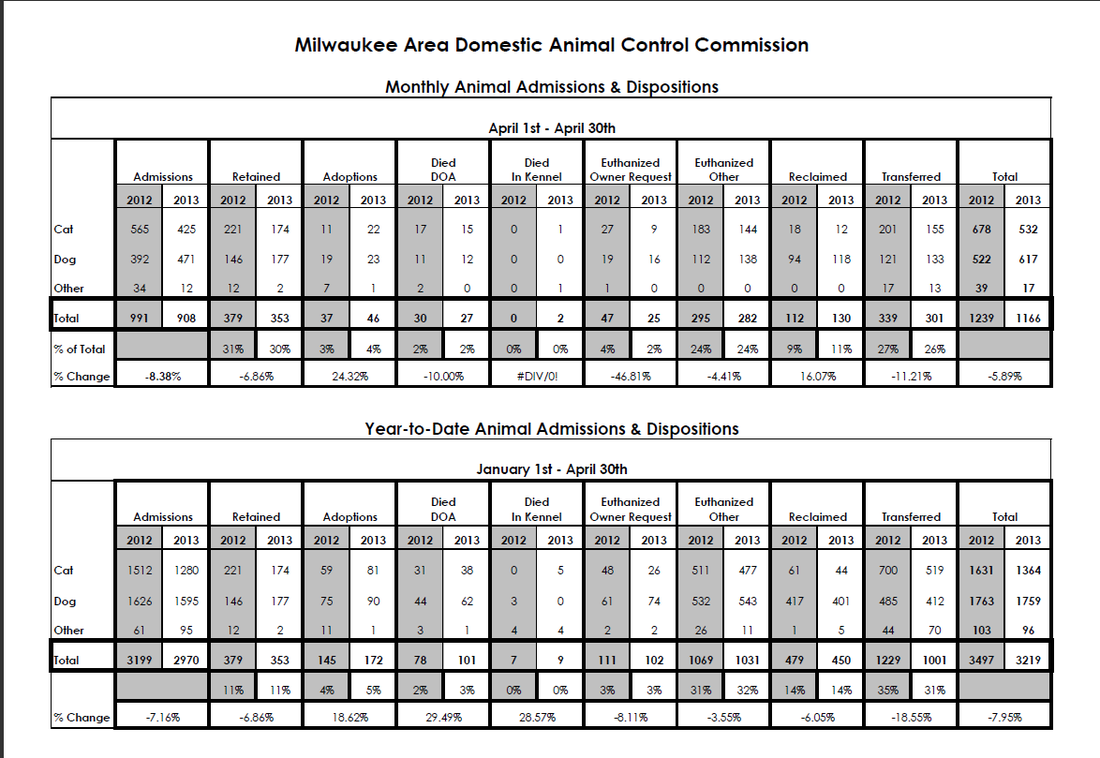|
Milwaukee Area Domestic Animal Control (MADACC) has killed 1031 animals so far in 2013. Five hundred forty three dogs, 477 cats and 11 other animals. Last year they had killed 1069 during the same period.
Intake is down for the year; but dog intake is up in April. Reclaims are down for the YTD. Transfers to other rescues and shelters are also down.
Progressive animal sheltering that saves lives relies on two things - reducing intake and increasing live outcomes.
Shelters can reduce intake by: proactively reuniting more lost pets with their families, preferably before they even reach the shelter; offering low cost spay and neuter services to the public; offering trap,neuter return programs for feral cats; and by reducing surrenders and "abandonment at the shelter" through excellent customer service and animal help desks.
Shelters can increase live outcomes by transferring animals to other rescues and shelters, offering medical and behavior rehabilitation; using volunteers to socialize, train and foster animals; and creating innovative adoption and marketing programs.
The busy summer months are ahead. More pets are outside, thereby more are lost and end up in the shelter system. Feral cats are having kittens which are often brought to animal control by Good Samaritans. If MADACC is going to succeed in reducing euthanasia by a significant amount in 2013, they will need to get on the right track quickly.
This past February, Governor Walker issued a press release announcing an $11 million domestic violence budget investment “aimed at protecting Wisconsinites by expanding care and centers for the abused and their children.”
www.walker.wi.gov/Default.aspx?Page=f267c1a7-bc59-4144-8841-71358c6c0e73 While Gov. Walker is to be commended for his commitment to keeping our families safe from dangerous abusers, what is noticeably absent is a commitment to keeping our families’ pets safe from those same abusers. One potential safeguard would be to enact a law that would allow courts to include family pets in domestic violence protection orders. According to the Humane Society of the United States 2012 Humane State Ranking report, 25 states have such a law in place, including Minnesota and Illinois. Madison attorney Megan Senatori supports such an idea. She is the president of SAAV (Sheltering Animals of Abuse Victims), a 501(c)(3) all-volunteer nonprofit organization dedicated to raising community awareness regarding the prevalence of animal abuse in families affected by domestic violence. Through a collaboration with Domestic Abuse Intervention Services and the Dane County Humane Society, SAAV also provides temporary, confidential shelter for the animals of domestic abuse victims for a period of up to 90 days, primarily through a network of foster homes. Megan co-founded SAAV with law school friend and colleague, Pamela D. Hart, in 2001. A shareholder at the Madison law firm of DeWitt Ross & Stevens S.C., Megan is also an Adjunct Faculty Member at the University of Wisconsin Law School and Marquette University Law School where she teaches a course in Animal Law. In a recent interview, Megan shared her views on why Wisconsin needs to bring pets into the discussion of domestic violence prevention and legislation. 1. What are your thoughts about the creation of a state law that would provide for protective orders for domestic abuse victims with pets? And are there statistics or studies to support the idea? State laws that provide for “pet protective orders” are critical to protecting domestic abuse victims and their animals. The exact form of these types laws vary, with some states simply allowing a domestic abuse victim to use animal abuse as a basis to obtain a restraining order for herself, while other states enable the court to also directly protect the animal from abuse by including the animal in the protective order. Regardless of the form, these types of laws are extremely important to protect domestic abuse victims with animals in their family. A 1995 study of women’s shelters in Wisconsin showed that 86% of the women had pets, and 80% of those women reported that the batterer had also been violent to their pet. Animal abuse is a tremendously effective (and traumatic) way for a batterer to exercise power and control over his victim. Three separate studies have documented that from 18% to 40% of women seeking shelter at a crisis center reported that concern for the welfare of their animals prevented them from seeking shelter sooner, in some cases for more than two months. Harming a beloved animal is a very real symbol of what the batterer can do to the victim. Victims understand that. We commonly hear from victims who did not leave their batterer, or who delayed leaving their batterer, because they did not have a safe place for their animal if they sought safety for themselves. When a batterer targets a family pet or other animal, there is no question it should be a basis for the victim to obtain a domestic abuse restraining order. Current Wisconsin law relating to domestic abuse restraining orders does not mention animal abuse. This is a very real problem that requires a legislative solution. 2. What are the benefits to having this law? Batterers know that they can torment and control their victims by abusing, or threatening to abuse, an animal that the victim dearly loves. Pet protective orders allow the domestic abuse victim to obtain a restraining order in that situation and, therefore, remove a "tool" from the arsenal of ways that batterers try to control their victims. 3. What can animal supporters do to help see this law created, sponsored, and enacted? Education and community outreach is the key to passing legislation to protect domestic abuse victims with animals. Many people simply do not realize that animal abuse is prevalent in families affected by domestic abuse. To achieve changes in the law, however, it is important that animal supporters move beyond preaching to the choir. We must look for commonality with folks who are simply not necessarily “animal lovers” or interested in laws to protect animals, because wide-spread support is critical to achieving legislative victory. 4. You teach a course in Animal Law at University of Wisconsin Law School and Marquette University Law School. Are there any other animal cruelty laws that you feel need to be created, revisited or amended in Wisconsin? If I had my “wish list” there are many changes that I would make to Chapter 951, Wisconsin’s Animal Cruelty and Neglect laws. While Wisconsin is ahead of many states, its animal protection laws are not nearly as comprehensive as some of our neighbors, such as Illinois. Illinois routinely ranks at the top of the list for animal protection laws because Illinois law addresses not only punishment for violations, but also progressively attempts to identify root causes. For example, Illinois includes provisions that enable a court to require counseling in animal abuse cases. Illinois law also contains a penalty enhancer when animal abuse occurs in front of a child. And, of course, Illinois allows animals to be included in domestic abuse protective orders. Research confirms that there is a relationship between animal abuse and crimes against humans. Therefore, a comprehensive scheme of animal protection laws is critical not only to protecting animals, but also to protecting our fellow human beings For more information on the link between animal abuse and domestic check out these resources: http://www.americanhumane.org/interaction/support-the-bond/fact-sheets/animal-abuse-domestic-violence.html http://www.aspca.org/fight-animal-cruelty/domestic-violence-and-animal-cruelty.aspx http://www.humanesociety.org/issues/abuse_neglect/qa/cruelty_violence_connection_faq.html Denice Ryan Martin, a volunteer with Wisconsin Voters for Companion Animals, is a freelance writer, licensed social worker and animal welfare advocate. She’d like to hear your thoughts on this topic. E-mail her at [email protected]
Milwaukee Area Domestic Animal Control (MADACC) has killed 747 animals so far this year through March 2013. (This does not include those that died in their kennel, were dead on arrival, or were owner-requested euthanasia).
Four hundred and four dogs, 332 cats and 11 other animals died at MADACC. The chart above shows the comparisons from last year to this year and also the breakdown of the March statistics. The new Executive Director, Karen Sparapani, started on February 16 so this is the first full month of statistics under her directorship. April statistics will not be available until after the May operations committee meeting. Intake is down (a good thing!) and so are shelter deaths. But unfortunately, reclaims and transfers are also down for the year. Progressive animal sheltering that saves lives relies on two things - reducing intake and increasing live outcomes. Shelters can reduce intake by: proactively reuniting more lost pets with their families, preferably before they even reach the shelter; offering low cost spay and neuter services; offering trap, neuter, return programs for feral cats; and by reducing surrenders and "abandonment at the shelter" through excellent customer service and animal help desks. Shelters can increase live outcomes by transferring animals to other rescues and shelters; offering medical and behavior rehabilitation; using volunteers to socialize, train and foster animals; and creating innovative adoption and marketing programs. |
Our blog will be an ongoing conversation regarding humane legislation and improved conditions for companion animals in Wisconsin. Feel free to contact us with your letters, ideas and input. wivotersforcompanionanimals @gmail.com
CategoriesAll ArchivesNovember 2020  RSS Feed RSS Feed
Authors
|
| Wisconsin Voters For Companion Animals |
|



